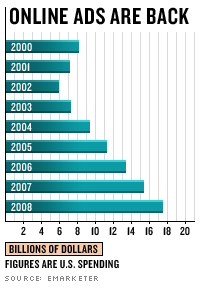NEW YORK (CNN/Money) -
Not that long ago, the idea of anyone shelling out nearly half a billion dollars for an online news site seemed not just unlikely but almost ludicrous.
The newspaper industry in general, and Internet news sites in particular, were creamed by the bursting of the tech bubble in 2000, as well as by the recession and steep drop in advertising dollars that followed.
Boy have times changed.
On Monday Dow Jones & Co. announced it would buy MarketWatch, owner of the financial news site CBS MarketWatch, for $519 million in a deal billed as a way for the publisher of The Wall Street Journal to expand its online audience and capitalize on a revived Internet ad market.
Executives at Dow Jones are not the only ones taking notice.
The Internet is now the nation's fastest-growing advertising medium, with sales expected to reach a record $9.4 billion this year -- up 16 percent from the bubble days. What's more, Internet research firm eMarketer expects companies will nearly double their annual Web ad spending by 2008.
Another sign of revival Monday: the Interactive Advertising Bureau (IAB) and PricewaterhouseCoopers said Internet ad spending jumped 35 percent to a record $2.4 billion in the third quarter from a year earlier, and were up 2 percent from the second quarter.
The ad revival is driving revenue spikes at some top news sites, including CNET, The New York Times Digital, and Knight Ridder Digital.
But strong ad sales overall are masking a challenge that many Web sites operators face: while demand is up, so too is the total supply of ad space available. That means ad rates aren't rising nearly as fast.
"There's more inventory in general," said Denise Garcia, a principal analyst with GartnerG2. "There is still more supply than there is demand for online advertising."
A tale of two markets
It's the paradox of the Internet's second act. While everyone reaped the benefits of skyrocketing rates during the late 1990s boom, this time around a handful of ad-driven sites are going gangbusters, with no available ad space.

Everybody else, however, is saddled with too much inventory. Companies like ValueClick (up $0.45 to $11.94, Research) and privately-held Blue Lithium, which specialize in aggregating sites' excess supply and selling it off cheap in exchange for a commission, are going strong.
"At a macro level I guess you could say that spending is going up," said Gary Stein, a senior analyst with Jupiter Research. But he estimates that about half of ad dollars spent online are going to four sites: Google, Yahoo!, MSN (owned by Microsoft (up $0.42 to $27.31, Research)) and AOL (which, along with CNN/Money, is a Time Warner (down $0.11 to $17.29, Research) property). From there, he said, "it starts to fragment pretty quickly."
Yahoo! (down $0.36 to $37.44, Research) and Google (up $3.18 to $185.18, Research) are on a tear because they dominate paid search advertising, which is by far the hottest form of online advertising. A IAB-PricewaterhouseCoopers survey shows that search advertising comprises about 40 percent of the total online ad market, up from nearly 30 percent a year ago.
The beauty of paid search is that the ads that appear are directly related to the keywords a consumer uses to conduct a Web search. A sponsor pays only if and when a user clicks onto the company ad that appears along with Web search results.
So, for instance, a mortgage lender will bid to have its ad appear next to a search of "mortgage rates." The assumption is that someone who's looking for a new house might be interested in finding out about loans.
Last month a bank paid on average $4.31, or 36 percent more than in September, for each mortgage-related search that ended in a click, according to Fathom Online, a San Francisco research firm that began tracking paid search rates in August. Fathom says prices for keywords jumped 14 percent last month, from September.
Web site operators that don't sell paid search advertising are discovering too that they can charge more if they can deliver the customer the marketer wants to reach.
All about eyeballs
Jason Vogelpohl is the vice president of advertising at TradingMarkets.com, a subscription-based information site for active day traders that draws advertising from financial services companies. If an advertiser wants to sell itself to, say, Canadian investors, Vogelpohl said he can command top dollar if he can produce them.
"The more you can tell advertisers about your demographic, the more money they will spend," said Vogelpohl.
The problem for Web sites that don't have the benefit of detailed subscriber lists is that they still don't know the faces behind the clicks.
To change that, some online publishers are embracing technology that tries to profile users based on all the pages they visit on a single site.
The idea is to help Web sites sell ads at higher rates on less-popular pages by, for instance, showing auto makers that site users head not only to the automotive section but also to information on the weather or general news.
But behavioral targeting technology is still in its infancy, said Garcia of GartnerG2. "It will be awhile before that really starts to take off," she said.

|

